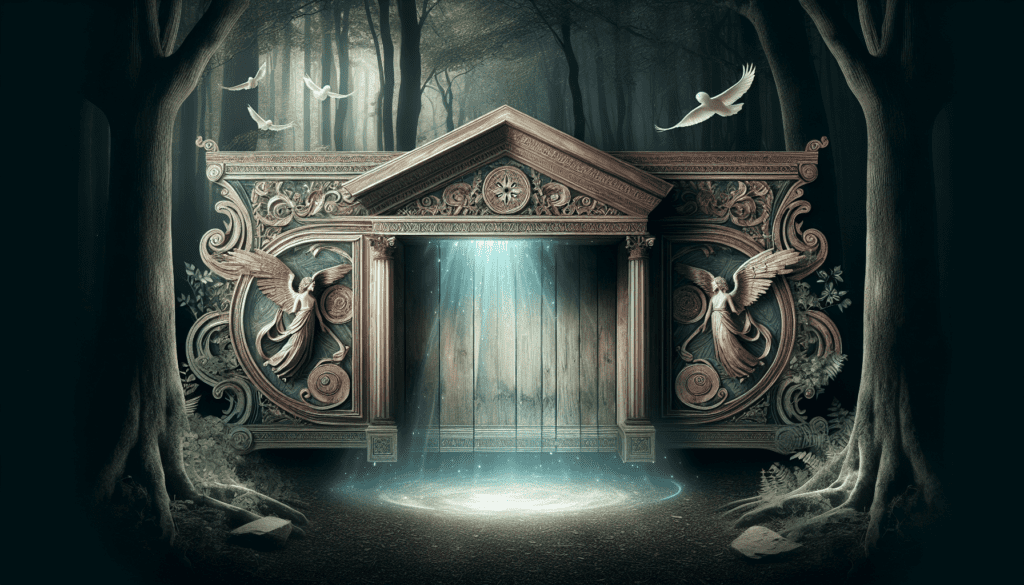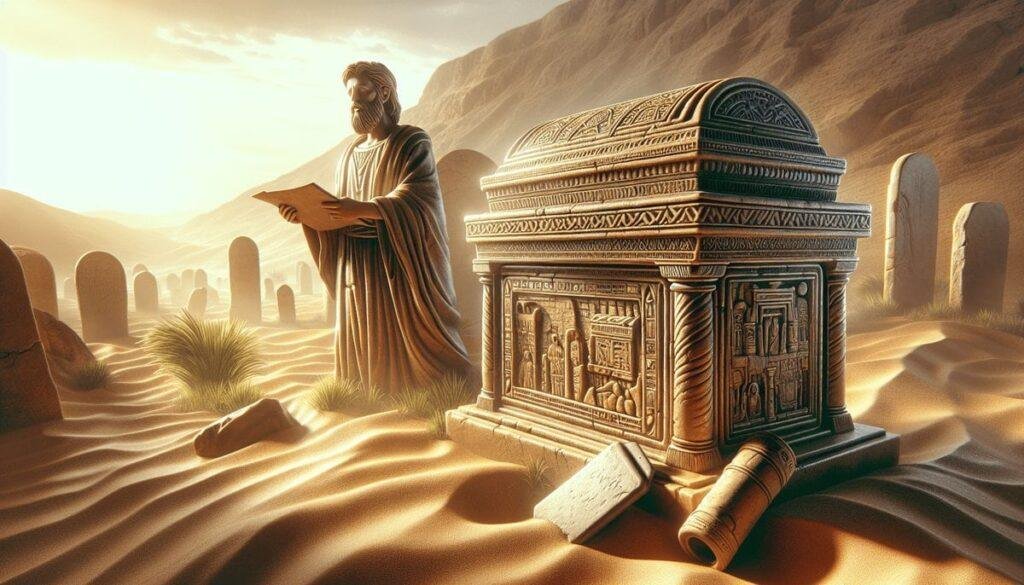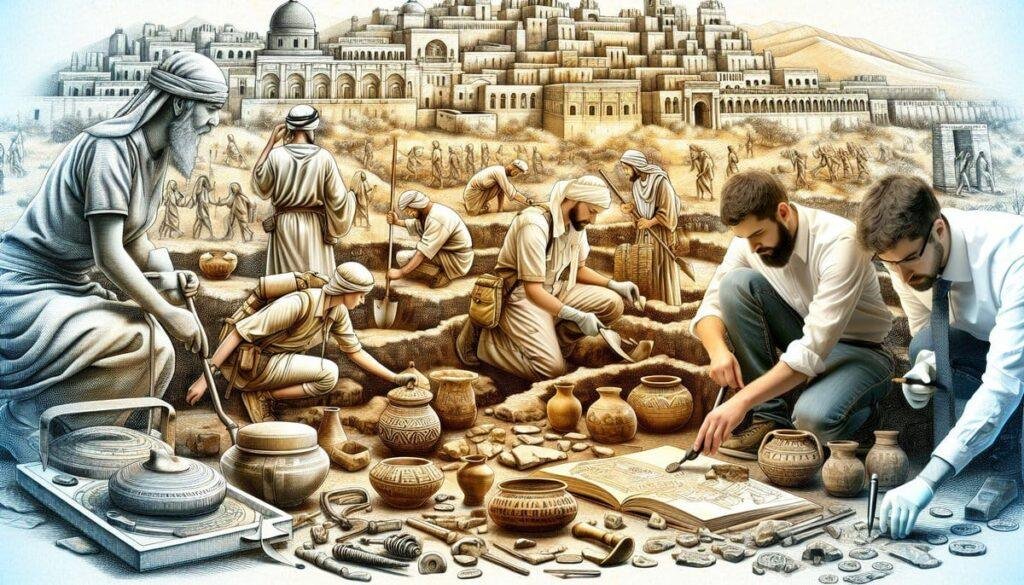Have you ever gazed at an ancient artifact and wondered about the stories it holds? The Ark of the Covenant, one of the most enigmatic objects in biblical history, is no exception. Its intriguing cover is graced by majestic winged figures that have sparked curiosity and debate among scholars, theologians, and history buffs alike. Let’s unravel this mystery together.

The Ark of the Covenant: A Brief Overview
The Ark of the Covenant is not just a relic; it’s a symbol of divine presence in the ancient world. According to biblical texts, it was constructed under the guidance of Moses, designed to house the tablets of the Law given by God on Mount Sinai. Imagine a golden chest, resplendent and awe-inspiring, meticulously crafted according to divine specifications.
- Dimensions: According to Exodus 25:10, the Ark measured 2.5 cubits long, 1.5 cubits wide, and 1.5 cubits high. This roughly translates to 45 inches long, 27 inches wide, and 27 inches high.
- Material: It was made of acacia wood and overlaid with pure gold, making it both durable and opulent.
The cover of the Ark, known as the “Mercy Seat,” is especially significant because it features the iconic figures of cherubim, which we will explore in greater detail shortly.
The Significance of the Mercy Seat
Understanding the Mercy Seat is key to grasping the full narrative of the Ark. It was considered the throne of God on Earth, where He would communicate with Moses and, by extension, His people.
Divine Communication
The ancient Israelites believed that God spoke from between the cherubim, making this area incredibly sacred.
- Scriptural Reference: Exodus 25:22 states, “There I will meet with you; and I will speak with you from above the mercy seat…”.
- Cultural Impact: This form of communication established the Mercy Seat as a pivotal point in the Israelites’ spiritual life.
If you can picture yourself among the Israelite people, witnessing rituals around this powerful symbol of God’s presence must have been both humbling and awe-inspiring.
The Role of Cherubim
But what about those winged figures? The cherubim are essential characters in this divine drama.
- Description: According to Exodus 25:18-20, cherubim were constructed to face each other, with wings outstretched above the Mercy Seat. Their faces and forms are not clearly defined in scripture, which has led to a range of interpretations over time.
Cultural Representation
The cherubim serve as more than mere decorations; they encapsulate important theological concepts.
- Symbolism: They are often depicted as guardians of sacred boundaries in various cultures, akin to the “guardians” of paradise found in Genesis. Hence, the very presence of these figures suggests protection of divine mysteries.

Archaeological Insights into the Ark
While biblical texts provide a foundation, archaeological findings give us a tangible link to the past.
Historical Context
Throughout history, the Ark’s existence has been in question. Many scholars have sought physical evidence to either substantiate or debunk its place in history.
- Biblical Archaeology: In the past century, archaeologists have unearthed everything from pottery to inscriptions that reference the Ark or similar concepts. However, it’s worth noting that no verified discovery of the Ark itself has surfaced.
The Temple of Solomon
One of the most crucial finds relates to King Solomon’s Temple, where the Ark was believed to be housed.
- Construction: The temple was built in Jerusalem around 957 BCE, as detailed in 1 Kings 6. This architectural wonder was designed explicitly to honor and house the Ark.
| Feature | Description |
|---|---|
| Dimensions | Approximately 90 feet long |
| Materials | Cedar, gold, and precious stones |
| Purpose | Worship and housing the Ark |
If you find yourself visiting Jerusalem today, exploring the remnants of this sacred site adds depth to the religious stories surrounding the Ark.
Theological Significance of the Cherubim
The cherubim are loaded with theological implications beyond their artistic representation.
Guardians of Holiness
In many ways, cherubim are depicted as guardians of the divine. Their presence signifies the gap between humanity and the divine, echoing themes of holiness and reverence.
- Traditional Roles: In Genesis, cherubim are placed at the east of the Garden of Eden, wielding flaming swords, guarding access to the Tree of Life.
Connection to the Divine
For the ancient Israelites, the cherubim represented a direct connection to God. They were not just ornamental; they were integral to honoring the divine presence, allowing believers to comprehend the significance of God’s interaction with humanity.
- Worship Implications: Worship practices centered around the Ark were deeply embedded in their culture, reflecting their understanding of divine favor and grace.
Artistic Representations Throughout History
Art has played a crucial role in interpreting the Mystery of the Ark and its winged figures.
Renaissance Interpretations
During the Renaissance, artists captured the beauty of biblical narratives, often depicting the Ark and its cherubim in various forms.
- Artistic Styles: Paintings from this era often emphasized emotion and spiritual significance, capturing the grandeur and mystery that surrounded the Ark and its cover.
Contemporary Depictions
In modern times, the cherubim continue to inspire artists, theologians, and historians alike.
- Symbol of Innocence: Pop culture often portrays cherubim as symbols of innocence or love, diverging from their ancient, more solemn significance.
| Modern Use | Description |
|---|---|
| Tattoos | Frequently designed as symbols of love and protection |
| Books and Media | Featured in various works reflecting their dual role as guardians and symbols of purity |
If you ever come across modern representations of cherubim, it’s fascinating to see how their meaning has evolved over time.
The Winged Figures in the Development of Monotheism
The transition from polytheistic beliefs to monotheism in ancient Israel was significantly shaped by the symbolism surrounding the Ark and its cherubim.
Shift in Worship Practices
Early worship in the region often involved multiple deities and images. However, the Ark, with its abstract representation of divinity through the Mercy Seat and cherubim, signaled a turning point.
- Emphasis on the Unseen: The cherubim showed that even in representation, the divine nature of God transcends physical forms.
Theological Reformation
As monotheism took root, the notion of God as a singular, unseen presence became central in Jewish belief, with the Ark symbolizing His covenant with His people.
| Abrahamic Faiths | Development of Beliefs |
|---|---|
| Judaism | God as a singular entity |
| Christianity | Continuity of God’s covenant |
| Islam | Acknowledgment of the same divine figure |
This transition in beliefs not only influenced religious doctrines but also influenced moral and ethical frameworks.
Mysticism and the Ark: A Spiritual Journey
Mystics have long been fascinated by the Ark’s spiritual implications. To them, it represents the human longing for communion with the divine.
Spiritual Symbolism
For mystics, the Ark embodies the search for divine truth and enlightenment.
- Inner Journey: Contemplation on the Ark and its cherubim serves as a reminder of the intersection between the earthly realm and spiritual enlightenment.
Modern Spiritual Practices
Many contemporary spiritual practices draw on the imagery of the Ark and its cherubim as a tool for meditation and connection.
- Mindfulness and Reflection: Engaging with the symbolism allows individuals to explore themes of protection, divinity, and human connection.
This journey into spirituality underscores that the Ark and its cherubim are not just relics of the past; they hold enduring power—beckoning to those who seek deeper meaning.
Summary: Bridging Ancient and Modern Perspectives
As we step back to reflect on the cherubim adorning the Ark’s cover, it’s evident that these winged figures serve as more than just artistic embellishments. They encapsulate a narrative that weaves through time, resonating with themes of divine presence, protection, and the essence of monotheism.
Whether you’re peering into ancient scriptures, wandering through archaeological sites, or contemplating modern interpretations, the Ark of the Covenant remains a powerful symbol. It connects the ancient with the contemporary, reminding us of the eternal human quest for understanding, meaning, and connection with the divine.
In your own life, consider how these stories and symbols continue to impact your understanding of spirituality and the mysteries of existence. The Ark, after all, invites us into a dialogue that transcends time and culture, enriching our journey through history, belief, and art.
So the next time you come across a representation or a mention of the Ark of the Covenant, let those winged figures serve as a reminder of the complexities of faith and the stories that each artifact carries. They prompt a question worth pondering: what stories do you carry, and how might they connect with the timeless narrative of existence?


